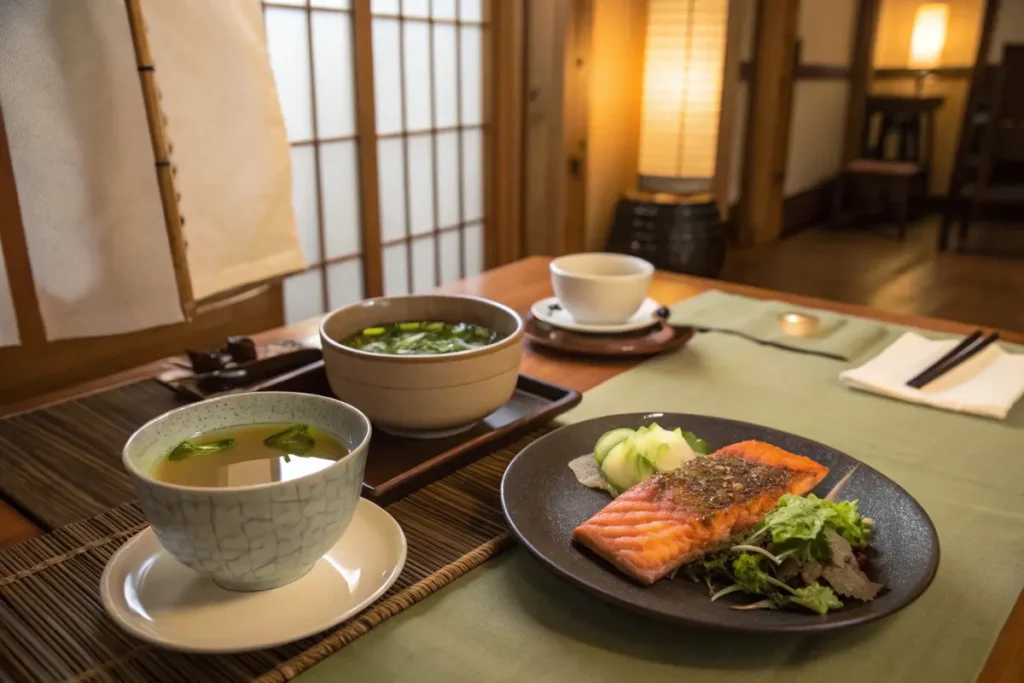If you’re looking to boost your health without sacrificing taste, healthy japanese recipes may be exactly what you need. Japan’s culinary traditions emphasize balance, fresh ingredients, and mindful portion sizes, making these meals naturally nutrient-dense and lower in calories. Indeed, japanese food diet principles often revolve around lean proteins, seasonal vegetables, and carefully selected condiments that add umami rather than excessive fats or sugars. Within the first few bites, you’ll appreciate why many consider Japanese cuisine a sustainable path toward wellness.
In this article, we’ll explore what is the healthiest Japanese food to eat—from light soups and vegetable-focused dishes to protein-rich sushi and grilled proteins. We’ll also answer common questions like Is Japanese food good for dieting? and Is Japanese takeout healthy? By the end, you’ll have a clear understanding of how to integrate healthy japanese meals into your everyday routine. For additional ideas that fit a balanced lifestyle, don’t forget to check out our Japanese Vegan Recipes for even more plant-based inspiration. Let’s embark on a delicious journey to discover how Japan’s flavorful diet can help you achieve better health.

Why Japanese Food Is So Healthy
When people think of healthy japanese recipes, images of sushi, grilled fish, and colorful veggie sides often come to mind. But what truly sets Japanese cuisine apart is its emphasis on balance, nutrient density, and moderate portion sizes. Below, we explore the key reasons why the Japanese diet is not only delicious but also beneficial for overall health.
1. Nutrient-Dense Ingredients
Seafood and Lean Proteins: Many healthy japanese meals revolve around fish like salmon, mackerel, or tuna, which supply high-quality protein and omega-3 fatty acids. Soy-based products, such as tofu and edamame, offer additional protein sources low in saturated fat.
Seasonal Vegetables: A variety of veggies—like bok choy, daikon radish, carrots, and mushrooms—are staples in most Japanese recipes. These ingredients bring essential vitamins, minerals, and fiber to the table, helping you feel full without piling on calories.
2. Portion Control and Presentation
Small Dishes: In Japan, meals typically feature multiple small dishes rather than one oversized plate. This approach naturally encourages portion control, preventing overeating and facilitating diverse nutrient intake.
Mindful Dining: The culture celebrates the freshness and appearance of food. Chefs aim to highlight natural flavors rather than mask them with excessive oils or sauces, resulting in lighter, cleaner-tasting dishes.
3. Balanced Flavor Profiles
Umami Over Sugar: While sugar can appear in sauces like teriyaki, Japanese cuisine generally relies on natural umami flavors found in ingredients like miso, soy sauce, and dashi (broth made from dried bonito flakes and kelp). This helps keep sugar and fat content low.
Pickled and Fermented Foods: Another secret to healthy japanese food is the inclusion of fermented items such as miso, pickled vegetables, and natto. These deliver probiotics, aiding digestion and possibly reducing inflammation (What is the Japanese anti inflammatory diet?). By regularly consuming fermented fare, you can support a healthy gut microbiome.
4. Emphasis on Whole Foods
Less Processed Fare: A traditional japanese diet plan typically favors whole, unprocessed foods. For instance, unrefined complex carbohydrates—like brown rice—are more popular than quick-fix snack foods.
Plant Proteins: Many meals spotlight beans, soy, seaweeds, and vegetables. Even meat-based recipes often involve substantial veggie portions, ensuring a balanced macros ratio.
5. Lifestyle Factors
While diet plays a huge role, the Japanese lifestyle also supports better health. Activities like walking or biking as part of daily commuting are common, further contributing to lower obesity rates and improved cardiovascular health.
If you’re curious about incorporating some of these elements into your everyday cooking, explore our Mashed Japanese Sweet Potato Recipe for a nutrient-rich side that complements proteins and vegetables alike. Pairing mindful portion sizes with nutrient-dense foods is the hallmark of a japanese diet that supports both flavor and wellness.

Key Ingredients in Healthy Japanese Meals
To recreate authentic healthy japanese recipes at home, understanding the core ingredients is essential. These components aren’t just flavorful; they also contribute significantly to the healthful nature of Japanese cuisine.
1. Rice and Whole Grains
- Short-Grain Rice (White or Brown): While white short-grain rice is a standard staple, opting for brown rice increases fiber and micronutrients. This aligns with many a japanese diet plan focusing on whole grains.
- Noodles: Sobas (buckwheat noodles) and udon can also play a role, offering distinct textures. Soba, in particular, has higher protein and fiber than refined wheat noodles.
2. Protein Sources
- Fish and Seafood: Salmon, mackerel, sardines, and tuna are rich in omega-3 fats, crucial for heart health. Shrimp or scallops supply lean protein, as seen in our Japanese Scallop Recipe.
- Soy Products: Tofu, tempeh, and edamame are common in healthy japanese meals, offering an alternative to meat-based proteins without boosting saturated fats.
- Lean Meats: Chicken breast and lean beef cuts appear in smaller portions, often complemented by vegetables to maintain balance.
3. Vegetables and Seaweeds
- Green Leafy Vegetables: Spinach, bok choy, and komatsuna appear in stir-fries or soups, packing iron, calcium, and vitamins.
- Root Vegetables: Carrots, burdock root, and sweet potatoes (like satsumaimo) supply energy, antioxidants, and fiber.
- Seaweeds: Wakame, nori, and kombu are staples. Nori wraps sushi, kombu flavors soups, and wakame often appears in salads or miso soup. They deliver iodine and other minerals beneficial for thyroid function.
4. Seasonings and Condiments
- Soy Sauce and Tamari: Low-sodium varieties help reduce salt intake. Soy sauce imparts umami without excessive calories.
- Miso Paste: Rich in probiotics and protein, miso is a fermented product made from soybeans. Used in soups, glazes, and marinades.
- Mirin, Sake, and Rice Vinegar: These lightly sweet and acidic condiments provide dimension to dressings, sauces, and stir-fries without heavy creams or butters.
- Sesame Seeds and Oil: Adding a nutty depth, sesame seeds can garnish salads and stir-fries. Meanwhile, a little sesame oil goes a long way to introduce robust flavor.
5. Fermented Foods
- Pickles (Tsukemono): Quick pickles from cucumbers, cabbage, or daikon radish supply probiotics and palate-cleansing acidity.
- Natto: Fermented soybeans, recognized for its potent flavor and aroma, are high in vitamin K2 and beneficial bacteria.
6. Herbs and Spices
- Ginger, Garlic, and Onions: Common aromatics that enhance taste without adding excessive fats.
- Shiso and Green Onions: Leafy herbs that add brightness and a hint of citrus or onion-like notes, perfect for finishing a dish.
Lastly, to see how these ingredients come together in a classic recipe, you might visit our Japanese Pumpkin Recipe, which highlights the synergy of miso, soy sauce, and seasonal vegetables. Mastering these basic components will allow you to craft an array of healthy japanese meals suited to your dietary needs.
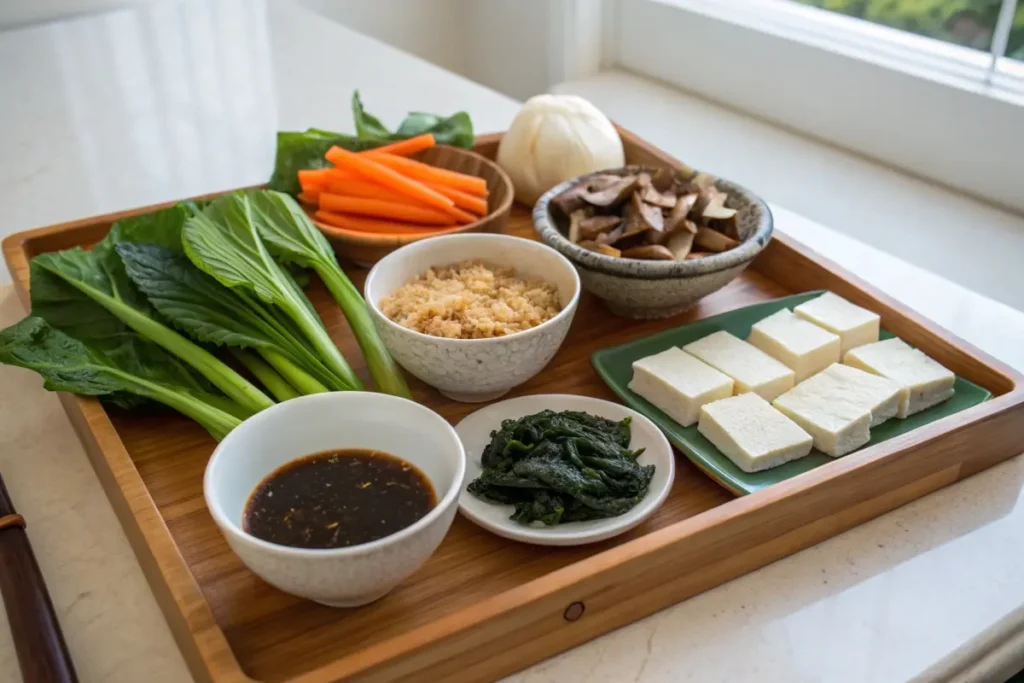
Four Healthy Japanese Recipes to Try
Once you’ve stocked up on nutritious staples, it’s time to explore some healthy japanese recipes that exemplify the best of this cuisine’s balanced approach. From light soups to hearty bowls, here are four dishes that blend taste, convenience, and health benefits.
1. Miso Soup with Tofu and Wakame
Why It’s Healthy:
- High in protein from tofu, plus beneficial microbes from miso.
- Wakame seaweed provides minerals like iodine.
Ingredients:
- 4 cups dashi (or vegetable broth)
- 2 tablespoons miso paste (white or red)
- 1 cup diced tofu (firm or silken)
- 1 tablespoon dried wakame
- Green onions for garnish
Method:
- Bring the dashi to a gentle simmer.
- Rehydrate the wakame separately in warm water for a few minutes, then drain.
- Whisk miso paste into a small amount of warm broth to dissolve before adding it back.
- Add tofu and wakame; heat gently, without boiling, for 1-2 minutes.
- Garnish with green onions and serve.
2. Salmon Teriyaki Bowl
Why It’s Healthy:
- Salmon is rich in omega-3 fatty acids, crucial for heart health.
- Light teriyaki sauce uses minimal sugar, focusing on soy sauce and mirin.
Ingredients:
- 2 salmon fillets
- 2 tablespoons soy sauce
- 1 tablespoon mirin
- 1 teaspoon grated ginger
- Steamed brown rice, bok choy, and carrots as sides
Method:
- Whisk soy sauce, mirin, and ginger to create a marinade.
- Coat the salmon and let it rest for 10 minutes.
- Pan-sear or bake at 375°F (190°C) until cooked through.
- Drizzle leftover marinade (cooked down for safety) over salmon.
- Plate over brown rice with steamed vegetables.
3. Chicken Sukiyaki (Light Version)
Why It’s Healthy:
- Uses lean chicken and an abundance of vegetables in a broth-based dish.
- Sukiyaki sauces typically have sugar, but you can reduce the quantity or use a healthier sweetener.
Ingredients:
- 8 ounces chicken breast, sliced
- 2 cups mixed vegetables (e.g., cabbage, mushrooms, onions)
- 1 tablespoon soy sauce, 1 tablespoon mirin, optional dash of sake
- 1 cup dashi or low-sodium chicken broth
Method:
- Lightly brown chicken in a pot or deep skillet.
- Add onions, mushrooms, and cabbage; sauté briefly.
- Stir in dashi, soy sauce, mirin, and sake; bring to a gentle boil.
- Simmer until chicken is fully cooked and veggies are tender.
- Serve immediately with a bowl of rice or noodles.
4. Soba Noodle Salad with Sesame Dressing
Why It’s Healthy:
- Soba noodles (buckwheat) contain more fiber and protein than regular wheat noodles.
- The sesame dressing is flavorful without heavy cream.
Ingredients:
- 8 ounces soba noodles
- 2 cups mixed greens or thinly sliced cucumber, carrots, and bell peppers
- 2 tablespoons sesame seeds (toasted)
- Dressing: 2 tablespoons sesame oil, 1 tablespoon rice vinegar, 1 tablespoon soy sauce, 1 teaspoon honey or sugar
Method:
- Cook soba noodles according to package directions; rinse in cold water.
- Whisk dressing ingredients in a small bowl.
- Toss noodles with vegetables and sesame dressing.
- Garnish with extra sesame seeds and enjoy chilled or at room temperature.
For a tasty side to these dishes, you can explore our Japanese Radish Recipe for refreshing salads or pickles that add crunch. These four options illustrate how a japanese diet can integrate easily into busy lifestyles, blending bold flavors with sound nutrition.
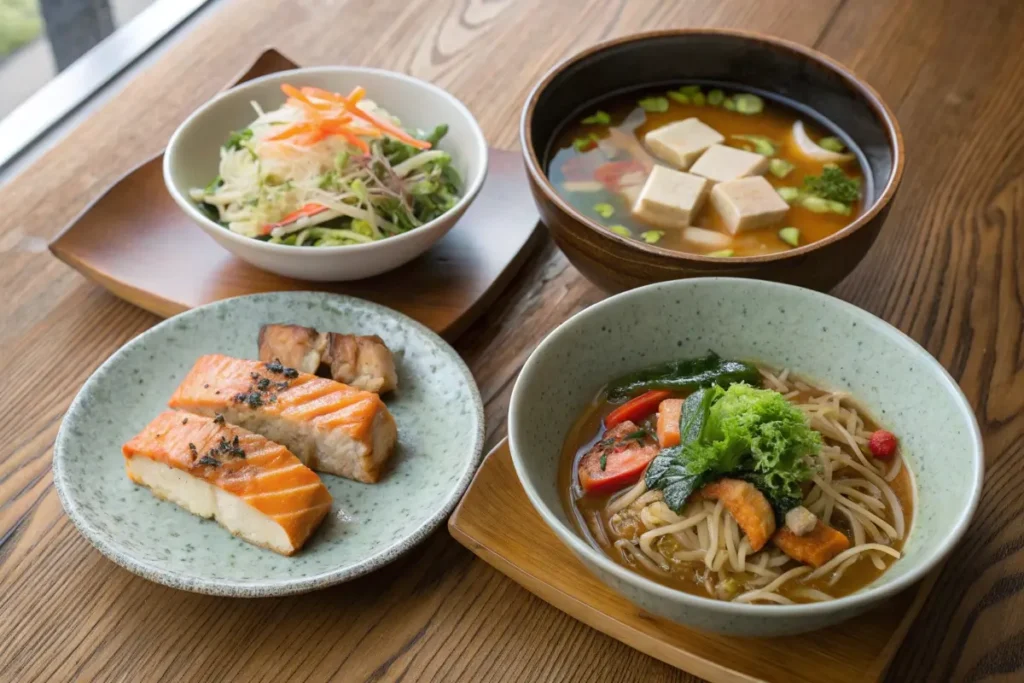
The Japanese Diet Plan Approach
You might have heard about the longevity of people in Japan and wondered, Is Japanese food good for dieting? The answer often lies in the structure of a typical japanese diet plan. It’s less about strict calorie counts and more about overall habits and food philosophies that encourage a healthy lifestyle.
1. Smaller Portions, Greater Variety
A healthy japanese food plate usually features multiple small portions of various dishes—like grilled fish, miso soup, pickled veggies, and steamed rice. This variety helps ensure you get a wide range of nutrients while naturally controlling portion sizes. By tasting multiple flavors in one meal, you’re also less likely to crave excess sweets or snacks later.
2. Balance of Macronutrients
Complex Carbs: Rice and noodles are eaten in moderation, often paired with high-fiber vegetables or proteins to slow down glucose release.
Lean Protein: Fish, chicken, tofu, and other soy products deliver protein without excessive saturated fats.
Healthy Fats: Omega-3 fatty acids from fish, minimal cooking oils, and occasionally sesame oil for flavor keep fat intake moderate.
3. Emphasis on Freshness and Seasonality
Japanese cuisine heavily incorporates seasonal produce, which not only boosts flavor but also ensures a rotating cycle of vitamins and minerals throughout the year. This approach fosters a connection to nature—trendy “farm-to-table” movements in the West have been part of Japan’s dining culture for centuries.
4. Mindful Eating
Slow Pace and Appreciation: Meals aren’t typically rushed. Chewing thoroughly and appreciating each bite leads to better digestion and a sense of satisfaction with smaller amounts of food.
Cultural Practices: Common phrases like “Itadakimasu” (said before eating) and “Gochisousama deshita” (after finishing) encourage gratitude and mindfulness around food.
5. Low in Processed Sugars
While sweets exist in Japan—think matcha-flavored desserts—they’re usually portioned modestly. Sweeteners like sugar or honey are used sparingly in sauces, letting the umami from ingredients like miso and soy sauce take center stage.
6. Intermittent Fasting or Light Meals
Some Japanese diets incorporate or align with intermittent fasting principles naturally. For instance, a light breakfast of miso soup and rice, a modest lunch, and a balanced dinner can unintentionally create longer fasting windows at night.
To broaden your healthy meal repertoire, consider referencing our Japanese Chicken Fried Rice Recipe for a satisfying option that still adheres to portion control and nutrient balance. Incorporating these habits into your daily life can form a robust foundation for weight management and overall well-being.
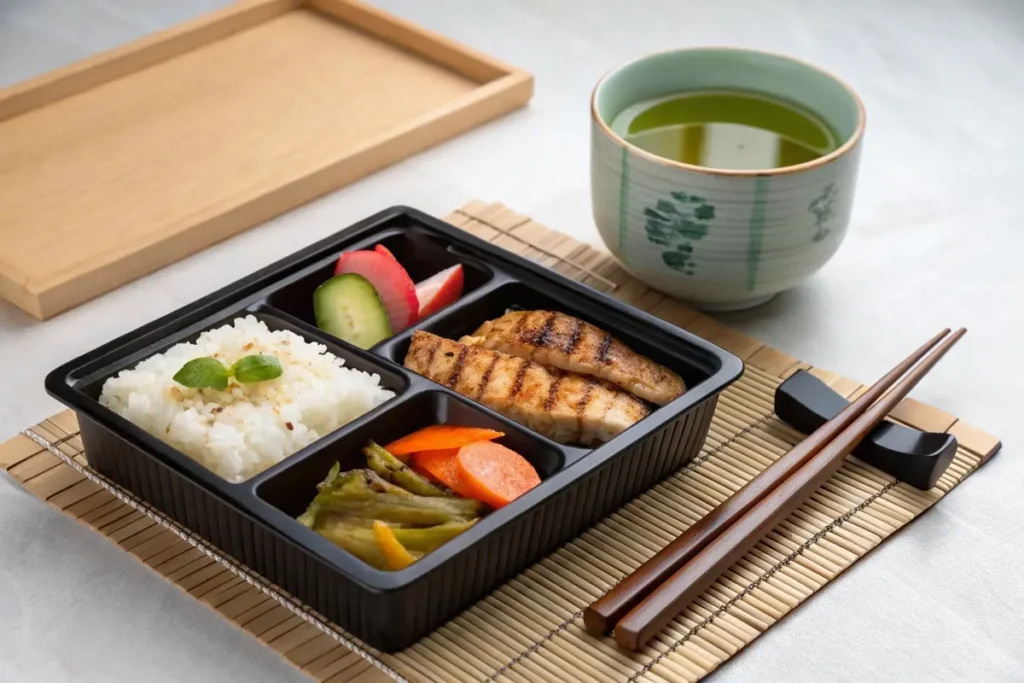
History and Context of Healthy Japanese Recipes
To fully appreciate healthy japanese recipes, it helps to know where they originated and how they evolved. Japan’s culinary history spans centuries of farming innovations, religious influences, and cross-cultural exchanges—all contributing to the balanced meals we see today.
Ancient Roots
In ancient times, Japan’s staple was rice, supplemented by fish, vegetables, and occasionally game meat. The isolation of the islands meant that local fisheries thrived. Seaweed, easily harvested from the abundant coastline, became a common feature in soups and side dishes. This reliance on marine and plant life laid a nutritional foundation that would shape the Japanese approach to food for generations.
Influence of Buddhism
Buddhism arrived in Japan around the 6th century, encouraging vegetarian practices among certain communities—especially monks. This is how shojin ryori, or Buddhist temple cuisine, emerged, focusing on vegetables, tofu, and grains. Although not everyone adopted strict vegetarianism, the emphasis on plant-based dishes and respect for natural flavors carried into mainstream cooking.
Opening to the West and Modernization
From the Meiji Restoration in the late 19th century onward, Japan began importing new ingredients like wheat, dairy, and meat. This led to the creation of “yoshoku” dishes—Western-inspired cuisine adapted to Japanese tastes. Over time, classics like tonkatsu (breaded pork cutlet) and curry rice became popular, although many of these were somewhat heavier than traditional fare.
Rise of Health-Conscious Eating
Over the last few decades, global awareness of Japan’s low obesity rates and high life expectancy sparked international interest in the japanese diet. Researchers studied how the combination of lean proteins (fish, tofu), moderate carb intake, and an abundance of vegetables contributed to longevity. This led to a spotlight on healthy japanese meals—particularly as Western diets increasingly faced issues of obesity and chronic diseases.
Contemporary Innovations
Modern Japanese chefs continue to refine dishes to suit evolving palates and dietary restrictions. Low-sodium soy sauce, sugar-free mirin alternatives, and gluten-free noodles are now accessible, allowing more people to enjoy Japanese flavors in a health-conscious manner. If you want to try a modern twist on a traditional concept, check out our Noodles Japanese Pan Noodles Recipe for a creative approach that still respects the cuisine’s fundamentals.
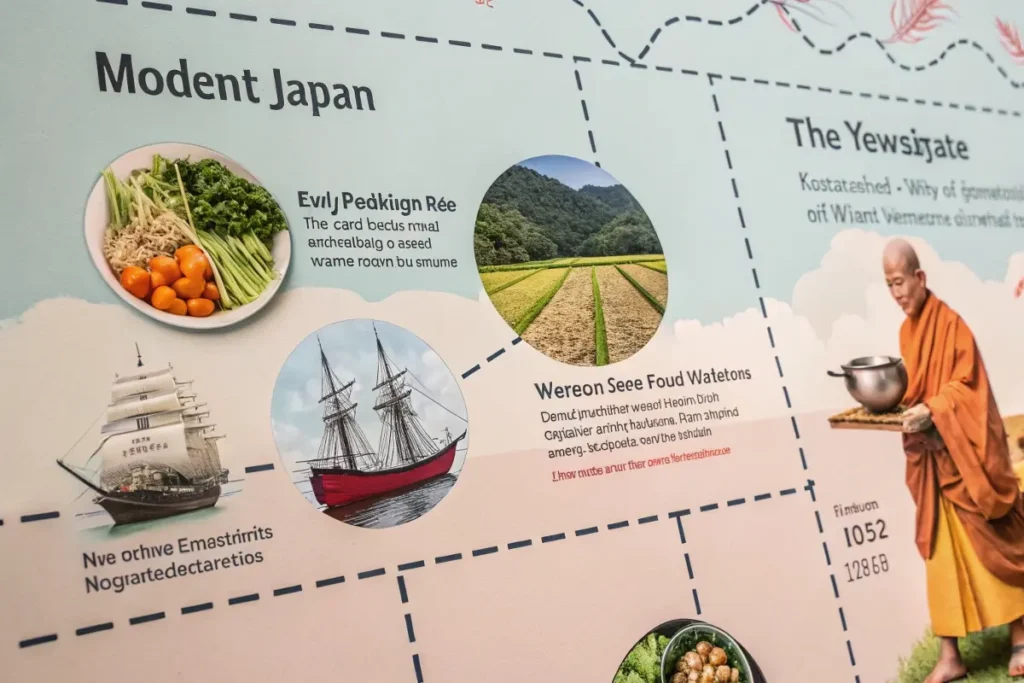
Practical Examples/Use Cases
Integrating healthy japanese recipes into your lifestyle doesn’t mean drastic changes. Below are a few actionable scenarios illustrating how you can seamlessly incorporate these dishes into everyday life, social gatherings, or personal health goals.
1. Weekly Meal Prep
- Scenario: You’re looking to maintain a balanced diet during busy workdays.
- Approach: Cook a batch of brown rice, marinate chicken or salmon in a low-sodium soy sauce mix, and chop a variety of vegetables in advance. Throughout the week, assemble quick meals like salmon teriyaki bowls or stir-fries.
- Benefit: You save time and reduce the temptation to order calorie-dense takeout.
2. Family Dinners
- Scenario: You want healthier yet tasty meals for the family.
- Approach: Prepare a large pot of miso soup, a platter of grilled fish, and a simple cucumber-wakame salad. Complement with smaller bowls of rice.
- Benefit: Balanced portions ensure each family member gets enough protein, fiber, and vitamins without feeling deprived.
3. Weight Management
- Scenario: You’re trying to shed a few pounds but hate bland diets.
- Approach: Focus on healthy japanese meals like soba noodles with vegetables or chicken sukiyaki with reduced sugar. Emphasize portion control by serving food in multiple small dishes.
- Benefit: The synergy of lean protein, fiber, and moderate carbs helps keep you satisfied while maintaining a calorie deficit.
4. Potluck or Party
- Scenario: Need a crowd-pleasing, nutritious dish.
- Approach: Whip up a soba noodle salad or a sushi platter featuring veggie rolls and fresh fish. Garnish with sesame seeds and drizzle with a homemade dressing.
- Benefit: Impress guests with a flavorful offering that also supports healthy eating habits.
For more ideas, you can explore our Easy Japanese Tuna Salad Recipe—a quick fix that easily adapts to a variety of dietary goals. These practical use cases demonstrate how flexible and accommodating a japanese diet can be, fitting into different lifestyles while consistently delivering on taste and nutrition.

FAQs About Healthy Japanese Recipes
Below are common questions that people have about integrating healthy japanese recipes into their diets, along with concise, informative answers.
- What is the healthiest Japanese food to eat?
Miso soup, grilled fish, and seaweed salads are all excellent contenders. Miso soup offers probiotics from fermented miso, while grilled fish like salmon supplies omega-3s. Seaweed salad adds vital minerals, making these items nutrient powerhouses in a healthy japanese meals lineup. - Is Japanese food good for dieting?
Yes. Japanese cuisine prioritizes fresh, low-fat ingredients, vegetables, and portion control. Many dishes incorporate fiber-rich foods and lean proteins. By focusing on moderation and variety, it naturally supports weight management and balanced eating. - What is the Japanese anti inflammatory diet?
An anti-inflammatory Japanese diet typically centers on fish high in omega-3s (e.g., salmon, mackerel), fermented foods like miso, and abundant fresh produce. These components reduce inflammation and support overall health, aligning well with the concept of japanese diet plan for longevity. - Is Japanese takeout healthy?
It depends on what you order. Sushi with fish and vegetables is usually lower in fat, whereas tempura or deep-fried items increase calorie counts. Opt for miso soup, sashimi, or veggie rolls, and moderate your intake of high-sodium sauces for a healthier experience. - Can I make Japanese dishes if I’m gluten-free?
Absolutely. Many Japanese recipes can be adapted by using gluten-free soy sauce or tamari, and substituting wheat-based noodles with rice noodles or 100% buckwheat soba. Read labels on sauces and seasonings carefully. - What about Japanese desserts?
Traditional Japanese sweets, such as mochi or fruit-based confections, usually come in smaller portions and have less sugar than Western desserts. For indulgent ideas that still lean lighter, see our Traditional Japanese Desserts Recipe. - How can I reduce sodium in Japanese meals?
Use low-sodium soy sauce, reduce salt in recipes, and rely on natural flavors from dashi or fresh herbs. Herbs like shiso, ginger, and green onions can heighten taste without piling on salt.

Conclusion
Embracing healthy japanese recipes can provide a sustainable, flavor-packed route toward better well-being. By prioritizing fresh seafood or soy proteins, colorful vegetables, whole grains, and fermented condiments, you’ll find that Japanese cuisine effortlessly balances taste and nutrition. This focus on variety, moderation, and seasonal produce helps support weight management, lower inflammation, and improved heart health—all without compromising on dining pleasure.
To get started, experiment with core dishes like miso soup, grilled fish, or soba noodles drizzled with a light sesame dressing. If you crave a more robust meal, consider combining these basics with a side dish from our Japanese Fried Rice Recipe—a lean twist on a classic comfort food. Over time, you can explore different flavors, from tangy pickles to sweet teriyaki glazes, steadily building a routine that merges convenience with healthy eating habits.
As you delve into the world of healthy japanese meals, keep in mind the core principles: balanced portion sizes, nutrient-dense ingredients, and mindful cooking techniques. With every bite, you’ll be part of a centuries-old tradition that values health, community, and respect for nature’s bounty. Enjoy the journey—your body and taste buds will thank you!
